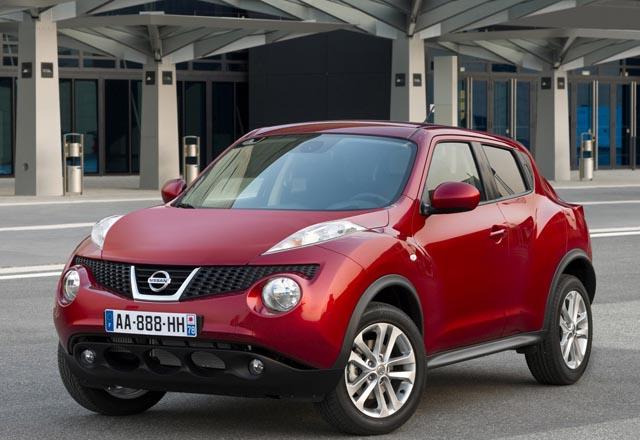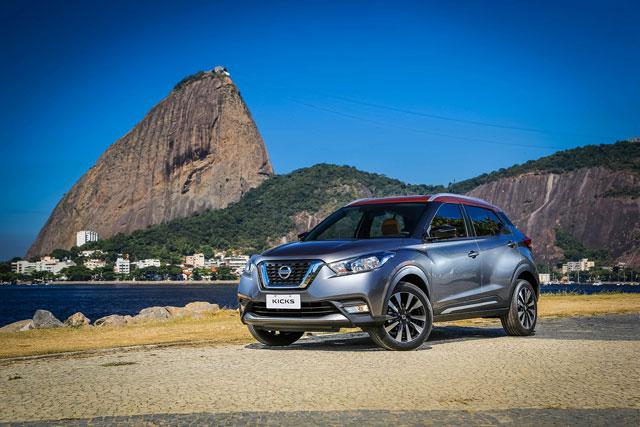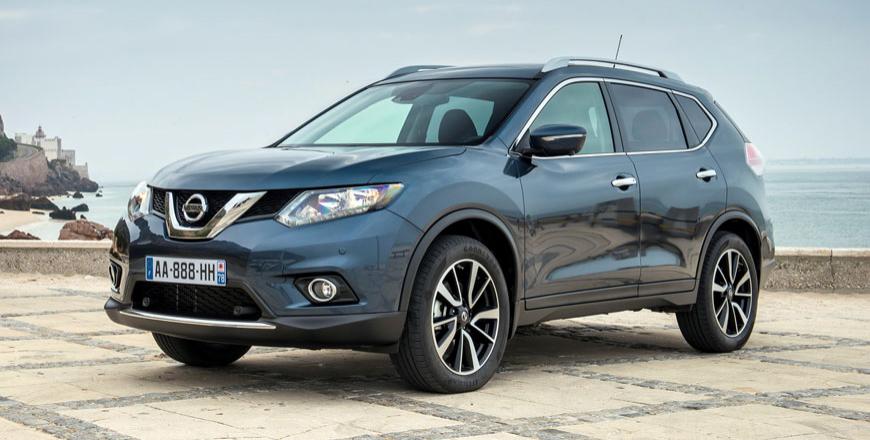You are here
Standout design and driving dynamics
By Ghaith Madadha - Aug 25,2014 - Last updated at Aug 25,2014

An unconventionally styled crossover vehicle sitting somewhere between compact hatchback and crossover SUV, the Juke is a bold gambit that has paid off handsomely for Nissan. Enthusiastically accepted by the car-buying public the Juke’s initial sales exceeded expectations when it was first launched as a 2011 model. Perhaps best described as a compact urban crossover vehicle largely aimed at a younger demographic, the Juke sits in relatively new market segment alongside the likes of the Kia Soul and Ford EcoSport. A car to be driven before being judged, under the Juke’s adventurous styling is the soul of a lively corner-hungry hot hatch.
Futuristic crossover
Whether one sees the Nissan Juke’s styling as a vibrant, bold and futuristically statement or just plain odd seems to be a matter of personal taste for most, but if anything, the Juke is far from being derivative, bland or boring. Seemingly finding a more receptive audience in young urban drivers, the Juke is an attention-grabbing car that stands out even among other futuristically designed vehicles. One found that its styling was more appealing after a test drive, where the sharp edges, buffed out wheel arches, rakish roof and slanted sports-car-like bonnet seemed to make more sense in light of darty driving dynamics.
Sitting 185mm off the ground, the Juke provides plenty of clearance to for urban bumps and potholes, and unpaved dirt roads too, but especially in the front wheel drive version as tested, the Juke is very firmly designed for on-road use. With wheels pushed wide apart for stability, the Juke also features bulging light clusters atop its front wings, which, like a sports car’s curves, help one place it on the road through corners. With wide grille and round lights set deep on either side, the Juke looks like little else, while its relatively long bumper and hidden rear door handles lend a sporty coupe-like demeanour.
Smoothly efficient
Driven with the base 16 valve 1.6 litre four-cylinder petrol engine option with continuously variable transmission (CVT), the Nissan Juke develops 115BHP at 6,000rpm and 116lb/ft at 4,000rpm. With a moderate 1,208kg weight this allows for an adequately quick 11.5-second 0-100km/h time and a 170km/h top speed, while combined cycle fuel consumption carbon dioxide emissions are frugal at 6.3l/100km and 145g/km respectively. Driven gently for fuel economy, the Juke’s 1.6 engine can feel slightly underpowered, but with more liberally aggressive use of the throttle it becomes considerably livelier, more responsive and eager — if less frugal — in its 4,000-6,000rpm sweet spot. Delivery throughout is smoothly progressive.
Driving the front wheels through the CVT transmission, the Nissan Juke’s variable ratios go through the gamut from 4.006:1 for quickest off-the-line performance to 0.55:1 at the top end for efficient and low-rev motorway cruising. Highly efficient and smooth with near imperceptible ratio changes, the CVT is designed and programmed to alter ratios by keeping engine speed at it most efficient range, especially in the “Eco” drive setting. With “sport” mode engaged and using forceful throttle inputs, the CVT becomes more amenable to engage lower ratios and to let the engine rev freely for more responsive performance and driver involvement.
Adept and agile
Livelier in “sport” mode, the Juke’s CVT has a selectable low ratio position, which encourages a more aggressive shift-pattern for inclines, but unlike other Nissan CVT applications, there are no selectable pre-programmed ratios to mimic a conventional gearbox for greater driving autonomy. On steep inclines the ‘low’ setting works fine, but it’s crucial to keep the engine revving hard to make quick progress. Through briskly driven winding cross country switchbacks where one would otherwise make numerous gear changes for braking, cornering and accelerating through apexes, one soon learns to finesse the throttle to adjust ratios when required and keep revs high for best performance.
With nimbleness not expected of a car this high off the ground, the Juke has the responses, agility and heart of a hot hatch. Light and quick at 2.76-turns, the Juke’s steering offers clarity, directness and good feel, and with a curt wrist flick turns in tidily. With a well-sorted chassis, the Juke turns tight corners with darty agility and pounces through narrow and snaking switchbacks with poised body control, crisp responses and alertness. Gripping tight, the Juke’s under-steer is easily corrected with slight throttle lift-off if provoked, and if desired, can be persuaded to slightly flick its rear to tighten a cornering line.
Buttoned-down
Stable through fast sweeping corners and on motorways, the Juke rides with smooth and buttoned-down reassurance. Over imperfect back-roads the Juke’s sportily firm MacPherson strut front and torsion beam rear suspension rates provided a fluent, comfortable and connected ride quality, only feeling slightly stiff over the most severe cracks and damaged tarmac. Rebounding with tight buttoned-down poise over crests, dips and expansion joints, the Juke bobbed slightly vertically over choppy roads, but didn’t jounce from side-to-side, and surprisingly proved more comfortable than more overtly comfortable cars. Finding a good compromise between firm and supple, the Juke’s 215/55R17 tires provide good steering feel.
Built on an enlarged Nissan-Renault platform shared by many of the alliance’s vehicles, including the superb Renault Clio RS, the Nissan Juke’s darty agility and confidence have the hallmarks of a potential hot hatch. Given a manual gearbox and powerful engine like the 187BHP 1.6-litre turbo variant or Nissan’s in-house tuning arm’s sportier 197BHP Nismo version, the juke could be a brilliant hot hatch. However, the version that best explores and showcases the Juke’s potential is the extreme Juke-R. Built in highly limited numbers, the 545BHP Juke-R pocket rocket is fitted with the Nissan GT-R supercar’s twin-turbo 3.8-litre V6 and four-wheel-drive system.
Cabin and kit
Refined inside, Juke cabin noise levels are very quiet in normal driving and on motorways, but engine drone is moderately present when pushed to its redline. Despite its low rear roofline the Juke’s front, over-shoulder and rear visibility quite good, while front seating is comfortably spaced and supportive. Ergonomic in front, one can find a good alert driving position, but no reach steering adjustability. A compact lifestyle car, the Juke’s rear headroom and door access isn’t designed for the especially large and tall but is well accommodating for average size occupants and children.
Well equipped, the tested Juke’s safety kit included ABS and electronic brake-force distribution, four airbags, electronic stability control, three rear three-point seatbelts and headrests, and two rear Isofix child seat latches. Convenience kit includes climate control system, remote central locking and under floor boot storage compartment. Minimum boot space is adequate at 251-litre volume but generously expands to 830 litres with rear seats folded. Cloth seats were pleasant, but one would have liked lumbar support for longer journeys. The Juke features a driving mode display with g-force and other infographics, while its six-speaker infotainment system features auxiliary jack, Bluetooth connectivity and steering controls.
TECHNICAL SPECIFICATIONS
Engine: 1.6 litre, transverse 4 cylinders
Bore x stroke: 78 x 83.6mm
Compression ratio: 10.7:1
Valve train: 16-valve, DOHC
Gearbox: Continuously variable transmission (CVT), auto, front-wheel drive
Gear ratios: 4.006:1–0.55:1
Reverse/final drive: 3.77:1/3.753:1
Power, BHP (PS) [kW]: 115 (117) [86] @ 6,000rpm
Specific power: 72BHP/litre
Power-to-weight: 95.2BHP/tonne
Torque, lb/ft (Nm): 116 (158) @ 4,000rpm
Specific torque: 98.2Nm/litre
Torque-to-weight: 130.8Nm/tonne
0-97km/h: 11.5-seconds
Top speed: 170km/h
Fuel consumption, urban/extra-urban/combined:
8.3-/5.2-/6.3-litres/100km
CO2 emissions, combined: 145g/km
Fuel capacity: 52 litres
Length: 4,135mm
Width: 1,765mm
Height: 1,570mm
Wheelbase: 2,530mm
Track: 1,525mm
Overhang, F/R: 855/750mm
Ground clearance: 185mm
Aerodynamic drag coefficient: 0.35
Cargo volume, min/max: 251-/830 litres
Kerb weight: 1,208kg
Suspension, F/R: MacPherson struts/torsion beam
Steering: Power-assisted, rack & pinion
Turning circle: 10.7 metres
Lock-to-lock: 2.76 turns
Brakes: Ventilated discs, 280 x 24mm/discs, 292 x 9mm
Tyres: 215/55R17
Price, as tested: JD23,800 (on-the-road)
Related Articles
Launched last year and rolled out in various American, Asian and Middle Eastern markets since, the Brazilian-built Nissan Kicks is a practic
Putting to one side the seemingly 1990s nostalgia-inspired marketing campaigns of rappers and lip-synching contests pushing hard to position
A more stylised successor to Nissan’s family crossover SUV, the new X-Trail’s is more assertive-looking and in line with Nissan’s familial d



















